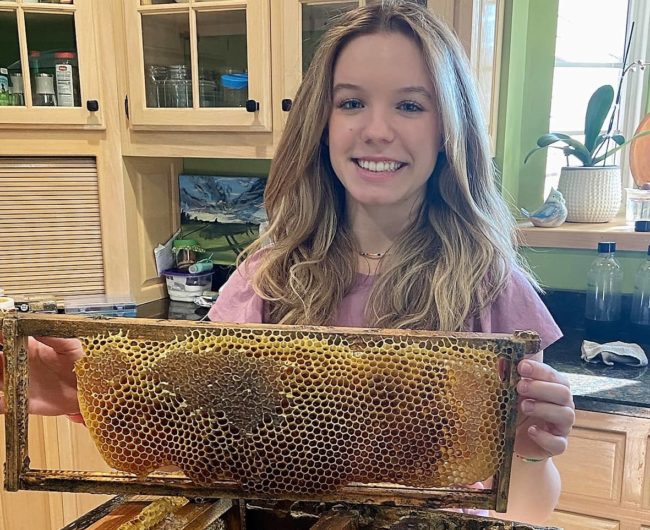
Carroll County, Tenn–Carroll County 4-Her Paige Costello is competing n the State 4-H Beekeeping Essay competition. The Beekeeping Essay Contest allows 4-H’ers to use their writing and research skills in developing an essay on a beekeeping-related topic. Paige and her family own and operate Camp Costello Farms Honey in Hollow Rock, Tennessee.
The following is Paige’s essay:
Why Is Beeswax Important?
By Paige Costello
When anyone mentions the word honeybee, Apis mellifera, one usually first thinks of
the sweet treat of honey they produce, but there is another product they make that may be
just as useful to both bee and humans and that is beeswax. While humans use it in many ways,
honeybees use the wax for storage, brood control, and communication within the beehive.
Beeswax plays an important and beneficial role in the activities that occur in the colony along
with projects outside of their hive.
Beeswax is naturally occurring wax and produced by honey bees. It is secreted in a flake
form from the abdominal glands of the female honeybee. The composition of beeswax consists
of different compound groups that are made in different amounts based on both the species of
honeybee and their location5. The bees form it into a hexagonal shape which provides great
strength to support the weight of the beehive. Newly made beeswax is white in appearance,
and can range in colors from white to yellow to almost black, depending on the age and diet of
the bees. It becomes darker with use inside the hive as pollen and larval debris are
incorporated1.
In beekeeping, beekeepers may provide the foundation on which the honeybees build
the wax into hexagonal cells. Wax production and comb construction activity in the bee colony
are determined by several factors, like the amount of nearby nectar flows, the presence of
pollen as a protein source, and the number of eggs the queen lays. The greater the need, the
more wax is produced3. Therefore, beeswax is of great importance because it is used to make
the foundation and honeycomb hexagonal cells for the bee’s “pantry” storage and organization
of the nectar and pollen they collect, as well as the honey they produce. The more storage for
these goods, the better the colony can reproduce and survive seasonal conditions, such as dry
summers (dearth) or long cold winters, without incoming food.
Honeybees also produce beeswax cells for the queen to lay her eggs in, which form a
nursery of bees in the hive. The more available wax cells, the more eggs she lays. The wax cups
are important because they help to protect and cradle the queen’s eggs as they mature into
larvae and prevent them from drying out 4. If the queen feels she has ample room to lay within
the hive, it may also prevent swarming of the bees when the colony size increases. The more
bees that emerge, the better they can protect the hive.
A final important attribute of beeswax in the hive is that it serves as a “dance floor” in
bee communications. Beeswax is the network that runs throughout the entire hive. It is where
bees convey imperative information to one another about the direction and distance the
location of resources through their waggle dance on the beeswax dance floor2. Beeswax
provides the surface area to quickly relay the message for this incoming news from the field.
For humans to utilize this great bee product, beeswax is obtained after the removal of
the honey by melting the honeycomb, straining the wax to remove impurities, and pressing the
residue to extract any remaining wax. Beeswax is used for the making of wax foundations. It
also has many major commercial applications, including candle making, metal castings,
modeling in cosmetics, and polishes. It is one of the most useful natural, industrial waxes. Most
mixtures made with beeswax are smooth and inert with other recipe additives.
Beeswax has been used around the house in many ways because of its diverse
applications. While I have made the traditional homemade soaps, candles, lip balms




